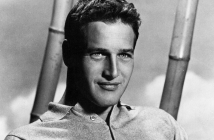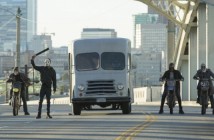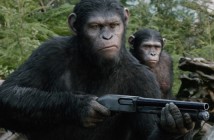10. Incident by a Bank (2009)
With an admirably Aristotelian unity, Ruben Östlund’s award-winning Incident by a Bank reenacts within a single take from a high vantage point across the street a bank robbery attempt in Stockholm. The film takes turns allowing the viewer to pick out and savor bits of the action on the mass canvas and zooming in on pertinent business, whether directly involved in the robbery or merely between bystanders. Two passers-by in particular notice something out of the ordinary and decide to film the incident themselves, adding another layer of surveillance to the narrative. Besides its technical achievement in mass choreography, the film is a marvel of shifting points of view, as the godlike viewer absorbs the actions and reactions of multiple individuals, some wryly funny and some unnerving. More than just a crime reenactment, the film eventually becomes a day in the life of the city, exploring human interaction on a wider yet less cumbersome scale than other, more sensational examples one can think of.
9. Essai d’ouverture (1992)
This delightfully escalating short film is by the French filmmaker and Cahiers du cinéma critic Luc Moullet, one of the least compromising and thus least well-known members of the French New Wave. His unabashed politics and love of B-movie Hollywood filmmaking led to interesting productions in the 1960s and 1970s, usually comedies that display deep knowledge of film history. Starting in the 1980s, he began making humorous shorts, including Essai d’ouverture (Opening Tries), in which the director shows various increasingly unlikely and desperate ways to open and drink from a Coke bottle, for a riotously deadpan fifteen minutes. A simple twist of the cap can’t suffice; outlandish tools and destructive techniques are introduced to semi-exhaustively document the possibilities of such a seemingly simple, offhand task. An upload of the film on Google Video is sans English subtitles, so the wit of Moullet’s matter-of-fact instructive narration may be lost, but the degree of invention and absurd conviction in his style approaches the comic sensibility of the great Jacques Tati.
8. The Musicians (1958)
Although the maker of short films has all the artistic breadth and depth at his disposal that is wielded by the maker of feature-length films, the short form has more potential to minutely portray the details of a seemingly prosaic event, raising it to the level of visual poetry. Such is the case with Kazimierz Karabasz’s brief documentary The Musicians, listed on Krzysztof Kieślowski’s 1992 Sight & Sound ballot of greatest films and available on YouTube or on Criterion’s release of The Double Life of Veronique. Opening with a shower of sparks, it follows a group of tramway workers from the railyard to a makeshift rehearsal space, where the workers pick up instruments and become a brass band. The rehearsal is equal parts tuning, cleaning, and playing, while a white-mustachioed conductor guides and shifts the individual elements. The workers are as dutiful in the brief snippet of railyard work at the beginning as they are in their obviously awaited-for rehearsal, expertly covered and cut together into a visual montage to accompany the harmonious instruments whose notes echo as the camera finally pans along the trams into a gradual fade to black.
7. Borom Sarret (1966)
The late, great Senegalese writer and director Ousmane Sembène’s short Borom Sarret is generally considered the first real film made in Africa by a black African, but it holds much more than simply academic interest. Its parable-like structure of a Dakar cart driver negotiating the new postcolonial Africa allows Sembène to make some critical points about the mindsets of the colonizer and the colonized while properly representing his own people in a way that they had never experienced before. The film captures daily life alongside the filmmaker’s clear satirical aims, a potent combination that he would utilize for the rest of his career. Borom Sarret the cart driver expects payment but tradition demands him not to ask for it, so exploitation ensues. Sembène even ties in a critique of gender politics in the finale, emphasizing how masculinity and ritual can hinder the modernization of society. Borom Sarret remains a committed and brave act of political filmmaking that never takes the easy way out or leaves any side off the hook for its part in history and the promise of a more fulfilling future.
6. Land Without Bread (1933)
Luis Buñuel’s sure blend of surrealist and ethnographic impulses, the half-hour Land Without Bread, came after his two other short masterpieces, Un Chien Andalou and L’Âge d’or, but shared their sense of anarchic, no-holds-barred freedom with form and narrative. Ostensibly an anthropological study of the Spanish region of Las Hurdes, and especially of its impoverished inhabitants, the film instead uses mordantly funny narration, bombastic music, and staged moments to depict a veritable hell on earth while confronting and exposing the usual documentary miserabilism so widespread and associated with colonialist depictions of native peoples even at that time. Buñuel’s bracingly matter-of-fact images can still shock today even as the reality of the documentary image has been undercut time and again since. There are multiple narrations and translations in existence, and YouTube has an English-narrated one.
5. (nostalgia) (1971)
Hollis Frampton’s (nostalgia) was recently released by Criterion in its place as part of a series of films called Hapax Legomena, but it stands on its own as a densely-packed work (Part 1 of which is on YouTube here). The short format’s length rewards multiple viewings in a simply logistical way that its feature-length counterpart does not, and Frampton’s multi-layered work of self-critical autobiography, exorcism of memory, and playful disjunction of sound and image can be savored in several different ways. On one level, the film’s narration (read by Canadian avant-garde legend and friend of Frampton’s Michael Snow) gives clues to Frampton’s past in photography as a series of black-and-white photographs are shown and then burned on a hot plate. The trick is that the narration explicates the photograph after the one that it is read on top of, forcing the viewer to match what he hears to the future and what he sees to the past. After a few examples, this becomes a simpler task, freeing up the mind to focus on how the words and images play up the ephemerality of memory and the illusory permanence of photographic (and thus cinematic) reality.
 4. The Book of Mary (1986)
4. The Book of Mary (1986)
Packaged with Jean-Luc Godard’s exceedingly controversial Hail Mary, his wife and frequent collaborator Anne-Marie Miéville’s The Book of Mary is a moving work of art in its own right. It opens with contentious if resigned voices emanating from a series of visual still lives until we alight upon a couple getting divorced, their precocious daughter Marie/Mary becoming the subject of the narrative. She flits here and there, appearing to suppress her knowledge of the ensuing separation, but her emotions seem to peek out at certain moments, including a scene of admirably comfortable nudity on her mother’s part and a scene where a comparably-aged friend brings up divorce. Lead actress Rebecca Hampton is superb at expressive physicality as well reciting Baudelaire with just the merest hint of really understanding it. Her reactions to the classical symphonies that frequently punctuate the various sequences go a long way in solidifying her psychic state, the true if unspoken core of Miéville’s short, heartbreaking film.
3. Two Solutions for One Problem (1975)
Like many of Abbas Kiarostami’s early shorts and features, Two Solutions for One Problem, the shortest of his short films, concerns children. Warmly didactic, it shows Nader and Dara, two schoolboys, and the two possible paths of resolution for one returning the other’s book with a tear in the cover. Like in Kiarostami’s later Orderly or Disorderly, the choice is between unity/cooperation/friendship and disorder/conflict/enmity, and the ramifications of each are depicted as the boys systematically escalate their conflict into breaking possessions and eventually physical violence. Jonathan Rosenbaum has aptly described the first, destructive solution to the problem as Laurel and Hardy by way of Bresson (YouTube link) for the near-comic exactness of destruction and the boys’ blank acting styles. The second solution is one boy helping the other repair the book by gluing the cover back together, thus preserving and perhaps even deepening their friendship. Two Solutions should be essential viewing for anyone over the age of five.
2. Ménilmontant (1926)
Ménilmontant is a landmark of the avant-garde as well as an exemplary short film, rife as it is with atmosphere and associative compression without any recourse to sound or intertitles. Much of the aesthetic arsenal of cinema at that time (including fades, irises, double exposures, close-ups, and rapid-fire montage) is brought to bear by French Impressionist filmmaker Dimitri Kirsanoff to create a fractured, elliptical tale of haunted and thwarted desire, as two orphaned sisters are seduced by the same man. Its slim storyline still comes bursting with violent, erotic, disorienting, and even downright mysterious images that nonetheless contribute to a matchless and modern psychological depth. Lead actress Nadia Sibirskaïa, Kirsanoff’s first wife, bridges the gap between Lillian Gish’s poverty-stricken beauty and Anna Karina’s prideful fragility, while the film itself balances its short narrative and bold stylistic elements in supremely cinematic terms. Available on YouTube.
 1. The House is Black (1963)
1. The House is Black (1963)
Iranian poetess Forough Farrokhzad’s only film is the short documentary The House is Black, a clear-eyed visual essay on the inhabitants of a leper colony and among the most humane films ever made. Farrokhzad was a different if no less powerful of an artist than Buñuel above, her strength coming from a radical, unflinching compassion for the quite ordinary daily lives of the striving, resolute individuals she found at the Behkadeh Raji colony (two of whom she subsequently adopted as her children). The film combines her own poetry with quotes from the Old Testament and Koran to almost will some kind of transcendence against the more dispassionate narration reporting the conditions of leprosy, just as the artistic, creative, and worshipful moments in the subjects’ lives bring about the most happiness. Although officially released by Facets, it’s also been uploaded to YouTube.



